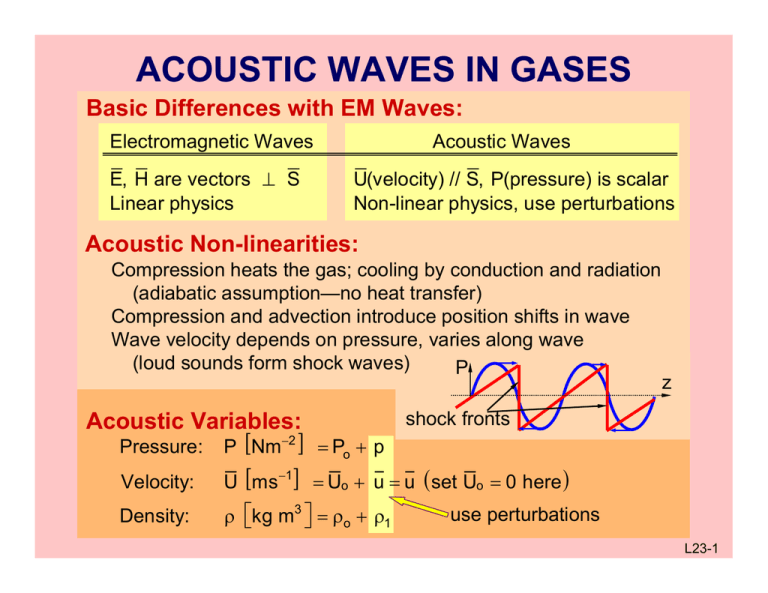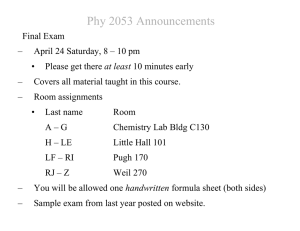ACOUSTIC WAVES IN GASES Basic Differences with EM Waves:
advertisement

ACOUSTIC WAVES IN GASES
Basic Differences with EM Waves:
Electromagnetic Waves
E, H are vectors ⊥ S
Linear physics
Acoustic Waves
U(velocity) // S, P(pressure) is scalar
Non-linear physics, use perturbations
Acoustic Non-linearities:
Compression heats the gas; cooling by conduction and radiation
(adiabatic assumption—no heat transfer)
Compression and advection introduce position shifts in wave
Wave velocity depends on pressure, varies along wave
(loud sounds form shock waves)
P
Acoustic Variables:
Pressure:
P [Nm−2 ] = Po + p
z
shock fronts
Velocity:
U [ms−1 ] = Uo + u = u ( set Uo = 0 here )
Density:
ρ ⎡⎣kg m3 ⎤⎦ = ρo + ρ1
use perturbations
L23-1
ACOUSTIC EQUATIONS
Mass Conservation Equation:
∂ρe
Conservation of charge
∂t
∂ρ
∇ • ρu = −
Acoustics:
Conservation of mass
∂t
∂ (ρo + ρ1 )
∂ρ1
(
)
=−
Linearize: ∇ • (ρo + ρ1 ) Uo + u ≅ −
∂
∂t
t
0
Drop 2nd order term (ρ1u )
∂ρ
Recall:
∇ • J = ∇ • ρe u = −
Linearized Conservation of Mass:
Linearized Force Equation (f = ma):
ρo ∇ • u ≅ −
1
∂t
∇p = −ρo ∂u
∂t
Constitutive Equation:
Fractional changes in gas density and pressure are proportional:
ρ
dρ 1 dP
=
⇒ ρ1 = ( o )p
ρ
γ P
γPo
"adiabatic exponent" γ = 5/3 monotomic gas, ~1.4 air, 1-2 else
3 Equations, 3 Unknowns:
Reduce to 2 unknowns ( p,u )
L23-2
ACOUSTIC EQUATIONS
Differential Equations:
∇p = − ρ o ∂ u
∂t
∂p
Conservation of Mass: ∇ • u ≅ − 1
γPo ∂ t
Newton’s Law (f = ma):
[Nm−3 ] [kg m-2s−2 ]
[s −1 ]
Acoustic Wave Equation:
ρo ∂ 2p
∇•∇p ⇒ ∇ p −
= 0 "Acoustic Wave Equation"
γPo ∂t 2
2
2nd spatial derivative = 2nd derivative in time
Solution:
p ( t,r ) = p ( ωt − k • r ) [Nm−2 ]
L23-3
UNIFORM PLANE WAVES
Example: assume p(t,r) = cos(ωt-kz):
∇p = − ρo ∂u ⇒ u = − zˆ ∫ 1 ∇p dt = zˆ k cos ( ωt − kz )
∂t
ρo
ρo ω
ηs-1
Substituting solution into wave equation
ρ
⇒ “Acoustic Dispersion Relation”:
k=ω o = ω
γPo c s
Acoustic Impedance of Gas:
ωρo
ηs =
= ρo γPo (ηs ≅ 425 Nsm-3 [≠Ω] for air 20°C)
k
Velocity of Sound:
Example:
Air at 0oC, Surface at Po
γPo
ω
= cs
Phase velocity: v p = =
⇒ cs ≅ 330 m/s
k
ρo
(G = 1.4, ρo = 1.29 kg/m3
−1
γPo
⎛ ∂k ⎞
Po = 1.01×105 N/m2)
v
c
=
=
=
Group velocity: g ⎜ ⎟
s
ρo
⎝ ∂ω ⎠
Velocity of Sound in Liquids and Solids:
cs = (K/ρo)0.5 ≅ 1,500 ms-1 in water, ≅ 1,500 – 13,000 in solids
“Bulk modulus”
L23-4
ACOUSTIC POWER AND ENERGY
Poynting Theorem, differential form:
Recall:
Note:
Try:
∂p
∇p = − ρo ∂u [Nm−3 ] [kg m-2s−2 ]
∇•u ≅ − 1
[s-1 ]
∂t
γPo ∂ t
Wave intensity [Wm-2 ] = pu [(Nm−2 )(ms−1 )]
[Watts]
∂p
∇ • up = u • ∇p + p∇ • u = −ρ o u • ∂u − 1 p
∂t γPo ∂t
2
∂
1
⎡
∇ • up = −
ρo u − 1 p2 ⎤ [W/m3 ] Acoustic Poynting
γPo ⎥⎦
2 ∂t ⎢⎣
Theorem
Integral form:
2
n̂da
⎡
p2 ⎤
u
∂
∫A pu • nda = − ∂ t ∫V ⎢ρo 2 + 2γP ⎥ dv
V
o⎦
⎣
-2
I[Wm ]
Wk [Jm-3] Wp
A
Acoustic intensity
Kinetic Potential
⎡⎣ Wm-2 ⎤⎦ :
ˆ
pu
•
n
Plane Wave Intensity
I
=
2
2
2
p
2
u
p
= ηs u [Wm-2 ],
Intensity: I(t) =
Io = I(t) = o = ηs o
ηs
2ηs
2
ηs = ρo γPo { ≅ 425 Nsm-3 in surface air}
Where:
L23-5
ACOUSTIC INTENSITY
Plane Wave Intensity I = pu • nˆ ⎡⎣ Wm-2 ⎤⎦ :
Intensity:
Where:
2
p
= ηs u [Wm-2 ],
ηs
ηs = ρo γPo {≅ 425 Nsm-3
I(t) =
2
2
2
po
u
= ηs o
Io = I(t) =
2ηs
2
in surface air}
Example: small radio at beach:
Io = 1 [Wm-2] at 1 kHz
⇒ po = 2ηsIo = 850 = ~ 30 [N/m2 ]
uo = po/ηs = 0.07 [ms-1];
Δz = 2uo/ω = 10 microns
Example: Threshold of hearing:
Ithresh ≅ 0 dB (acoustic scale) = 10-12 [Wm-2]
po
= 2ηsIo = 850 × 10 −12 = ~ 3 × 10 −5 [N/m2 ]
uo
= po/ηs = 3×10-5/425 ≅ 7 × 10-8 [ms-1]
-8
uo
7×10
≅2
≅2
= 2×10-11 [m] = 0.2 Å (< atom)
ω
7×103
Δz
L23-6
BOUNDARY CONDITIONS
Interfaces between gases or liquids:
Pressure: Δp = 0 (otherwise ∞ acceleration of zero-mass boundary)
Velocity: Δu⊥ = 0 (otherwise ∞ mass-density accumulation)
x
Rigid Boundaries:
ko θi θr
Pressure: Unconstrained
z
Velocity:
Δu⊥ = 0 (rigid body is motionless)
k
θt z
Reflection at Non-Rigid Boundaries:
Incident wave:
pi = po e − jki r = poe+jko cos θi x- jko sin θi z
Reflected wave:
pr = pr e − jkr r = proe -jko cos θr x- jko sin θr z
Transmitted wave:
Velocities:
pt = pt e − jk t r = ptoe+jkt cos θt x- jkt sin θt z
Same, but po,ro,to → uo,ro,to , pr,t → ur,t
Matching Phases: ⇒ Snell's Law: sinθi/sinθt = kt/ki =
k=ω
ρo
γPo
θr = θi
kt
ρt γ i
ρi γ t
−1 ⎛ c i ⎞
−1 ρ t γ i
sin
sin
θ
=
=
Critical angle: c
⎜c ⎟
ρi γ t
⎝ t⎠
L23-7
REFLECTIONS AT BOUNDARIES
Evanescent Waves (θi > θc):
”
“lunch!
warm
cool
x
pt
⎛c ⎞
θc = sin−1 ⎜ i ⎟
⎝ ct ⎠
θi
z
-j (k tcosθt )x- j (k t sinθt )z
-αx- j (k t sinθt )z
p
=
p
e
=
p
e
Recall: t
to
to
2
Where: cos θt = 1 − sin θ t and sin θt = ρi γ t / ρt γi sin θi > 1
So:
kt cos θt = ±jα
z
Normal Incidence, two gases:
− jk o z
+ jk o z
p : pie
+ pi Γe
= piTe
u : pi ηo − pi Γ ηo = piT ηt
− jk t z
0
→ 1+ Γ = T
at z = 0 ( Δp = 0 )
→ 1 − Γ = Tηo ηt at z = 0 ( Δ u⊥ = 0 )
Solving: T = 2ηt ( ηt + ηo ) where ηo = ωρo k = ρo γPo
Reflections from Solid Surface (n̂ • u = 0 ) :
u
L23-8
MIT OpenCourseWare
http://ocw.mit.edu
6.013 Electromagnetics and Applications
Spring 2009
For information about citing these materials or our Terms of Use, visit: http://ocw.mit.edu/terms.

